Abstract
The localization of sites of memory formation within the mammalian brain has proven to be a formidable task even for simple forms of learning and memory. Recent studies have demonstrated that reversibly inactivating a localized region of cerebellum, including the dorsal anterior interpositus nucleus, completely prevents acquisition of the conditioned eye-blink response with no effect upon subsequent learning without inactivation. This result indicates that the memory trace for this type of learning is located either (i) within this inactivated region of cerebellum or (ii) within some structure(s) efferent from the cerebellum to which output from the interpositus nucleus ultimately projects. To distinguish between these possibilities, two groups of rabbits were conditioned (by using two conditioning stimuli) while the output fibers of the interpositus (the superior cerebellar peduncle) were reversibly blocked with microinjections of the sodium channel blocker tetrodotoxin. Rabbits performed no conditioned responses during this inactivation training. However, training after inactivation revealed that the rabbits (trained with either conditioned stimulus) had fully learned the response during the previous inactivation training. Cerebellar output, therefore, does not appear to be essential for acquisition of the learned response. This result, coupled with the fact that inactivation of the appropriate region of cerebellum completely prevents learning, provides compelling evidence supporting the hypothesis that the essential memory trace for the classically conditioned eye-blink response is localized within the cerebellum.
Full text
PDF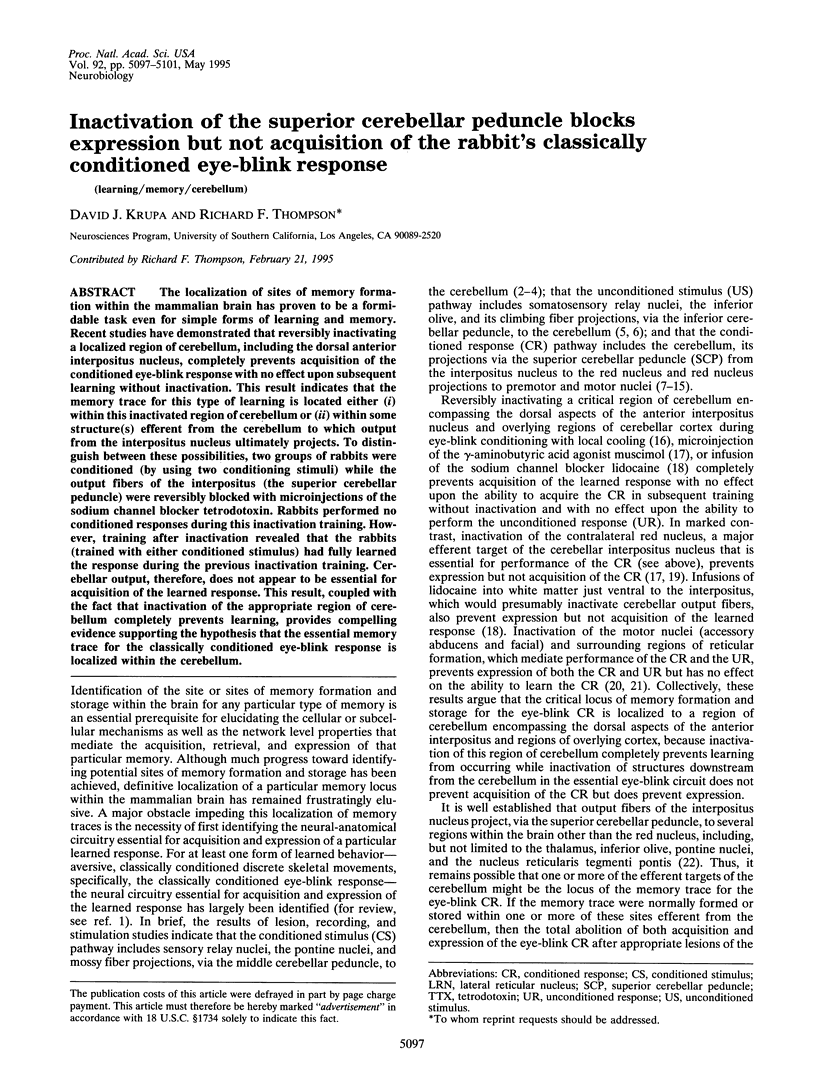
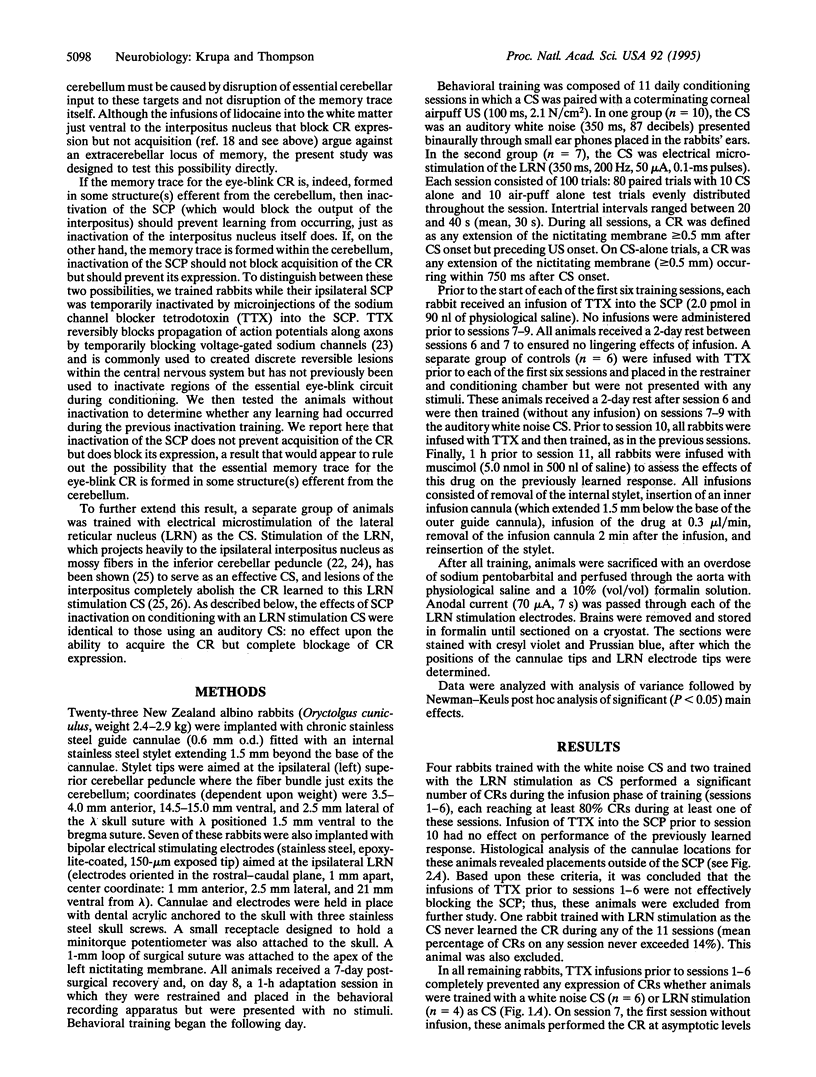
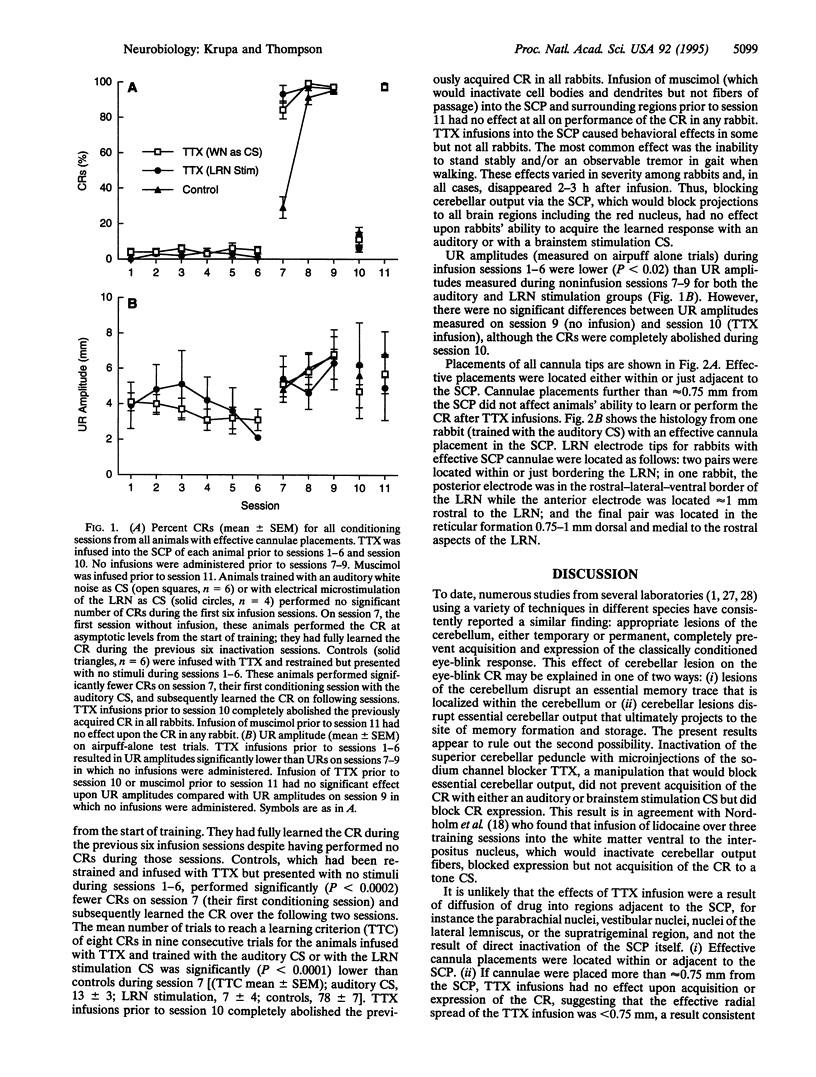
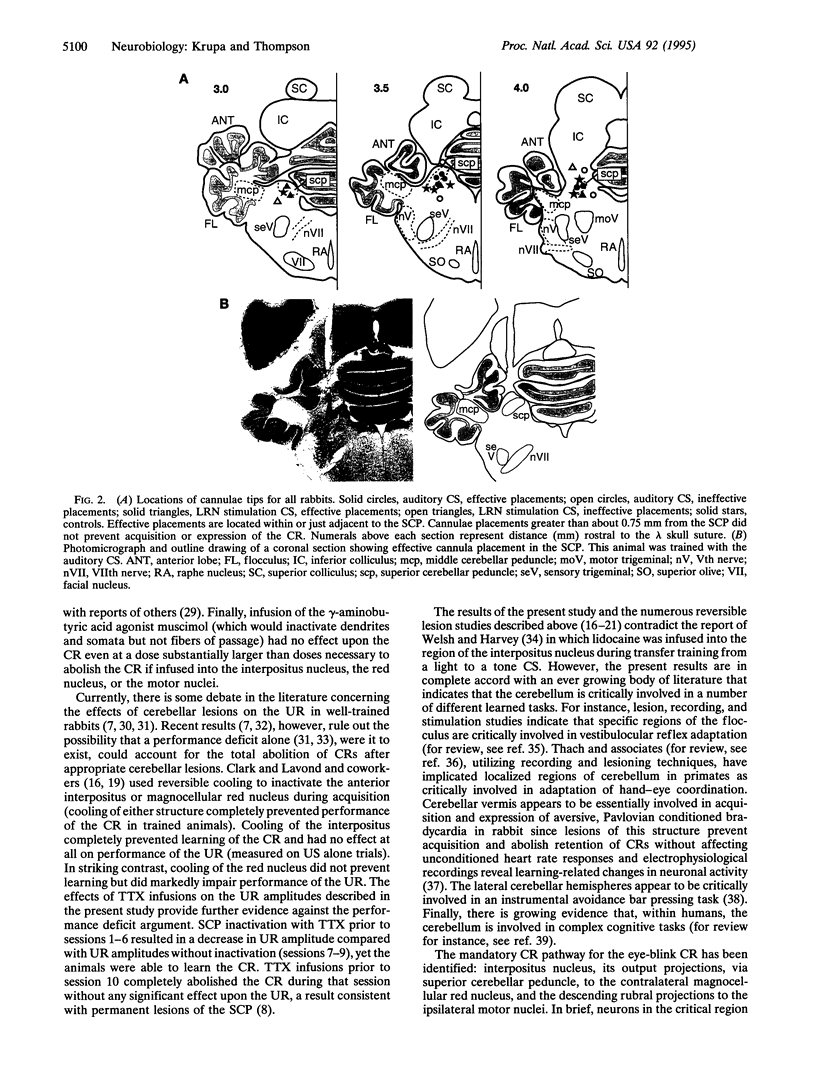
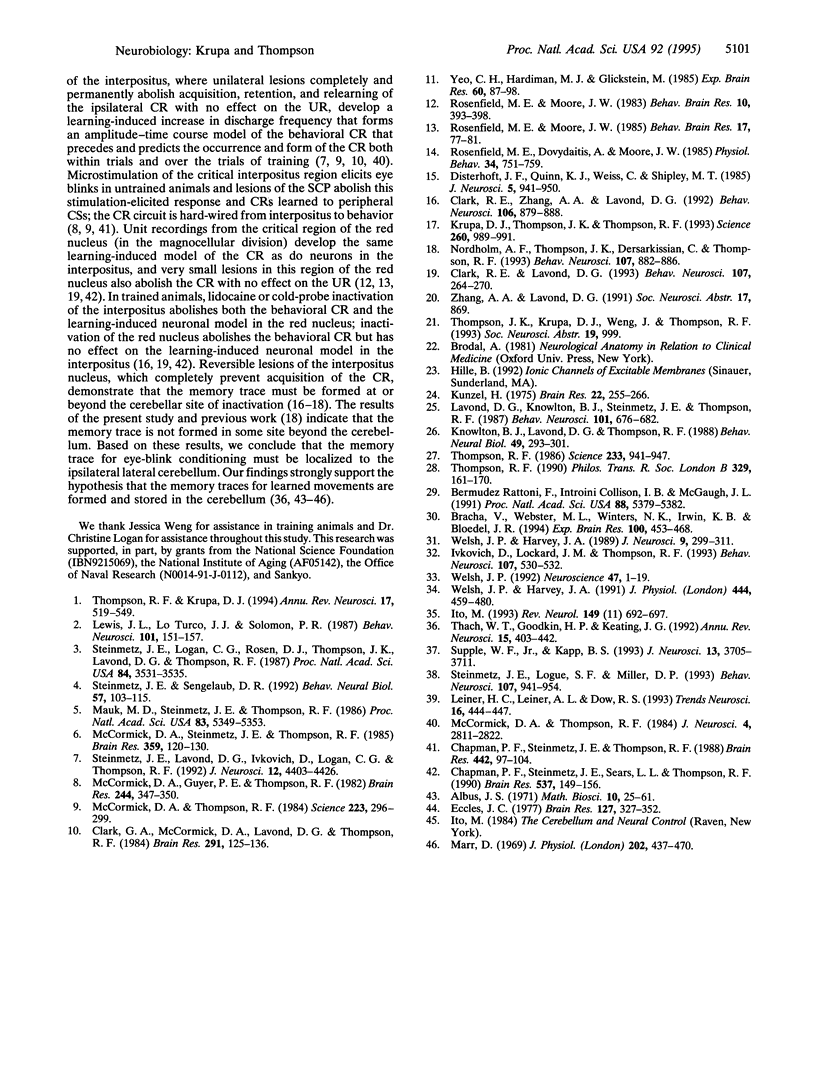
Images in this article
Selected References
These references are in PubMed. This may not be the complete list of references from this article.
- Bermudez-Rattoni F., Introini-Collison I. B., McGaugh J. L. Reversible inactivation of the insular cortex by tetrodotoxin produces retrograde and anterograde amnesia for inhibitory avoidance and spatial learning. Proc Natl Acad Sci U S A. 1991 Jun 15;88(12):5379–5382. doi: 10.1073/pnas.88.12.5379. [DOI] [PMC free article] [PubMed] [Google Scholar]
- Bracha V., Webster M. L., Winters N. K., Irwin K. B., Bloedel J. R. Effects of muscimol inactivation of the cerebellar interposed-dentate nuclear complex on the performance of the nictitating membrane response in the rabbit. Exp Brain Res. 1994;100(3):453–468. doi: 10.1007/BF02738405. [DOI] [PubMed] [Google Scholar]
- Chapman P. F., Steinmetz J. E., Sears L. L., Thompson R. F. Effects of lidocaine injection in the interpositus nucleus and red nucleus on conditioned behavioral and neuronal responses. Brain Res. 1990 Dec 24;537(1-2):149–156. doi: 10.1016/0006-8993(90)90351-b. [DOI] [PubMed] [Google Scholar]
- Chapman P. F., Steinmetz J. E., Thompson R. F. Classical conditioning does not occur when direct stimulation of the red nucleus or cerebellar nuclei is the unconditioned stimulus. Brain Res. 1988 Feb 23;442(1):97–104. doi: 10.1016/0006-8993(88)91436-9. [DOI] [PubMed] [Google Scholar]
- Clark G. A., McCormick D. A., Lavond D. G., Thompson R. F. Effects of lesions of cerebellar nuclei on conditioned behavioral and hippocampal neuronal responses. Brain Res. 1984 Jan 16;291(1):125–136. doi: 10.1016/0006-8993(84)90658-9. [DOI] [PubMed] [Google Scholar]
- Clark R. E., Lavond D. G. Reversible lesions of the red nucleus during acquisition and retention of a classically conditioned behavior in rabbits. Behav Neurosci. 1993 Apr;107(2):264–270. doi: 10.1037//0735-7044.107.2.264. [DOI] [PubMed] [Google Scholar]
- Clark R. E., Zhang A. A., Lavond D. G. Reversible lesions of the cerebellar interpositus nucleus during acquisition and retention of a classically conditioned behavior. Behav Neurosci. 1992 Dec;106(6):879–888. doi: 10.1037//0735-7044.106.6.879. [DOI] [PubMed] [Google Scholar]
- Disterhoft J. F., Quinn K. J., Weiss C., Shipley M. T. Accessory abducens nucleus and conditioned eye retraction/nictitating membrane extension in rabbit. J Neurosci. 1985 Apr;5(4):941–950. doi: 10.1523/JNEUROSCI.05-04-00941.1985. [DOI] [PMC free article] [PubMed] [Google Scholar]
- Eccles J. C. An instruction-selection theory of learning in the cerebellar cortex. Brain Res. 1977 May 27;127(2):327–352. doi: 10.1016/0006-8993(77)90550-9. [DOI] [PubMed] [Google Scholar]
- Ito M. Neurophysiology of the nodulofloccular system. Rev Neurol (Paris) 1993;149(11):692–697. [PubMed] [Google Scholar]
- Ivkovich D., Lockard J. M., Thompson R. F. Interpositus lesion abolition of the eyeblink conditioned response is not due to effects on performance. Behav Neurosci. 1993 Jun;107(3):530–532. doi: 10.1037//0735-7044.107.3.530. [DOI] [PubMed] [Google Scholar]
- Knowlton B. J., Lavond D. G., Thompson R. F. The effect of lesions of cerebellar cortex on retention of the classically conditioned eyeblink response when stimulation of the lateral reticular nucleus is used as the conditioned stimulus. Behav Neural Biol. 1988 May;49(3):293–301. doi: 10.1016/s0163-1047(88)90274-9. [DOI] [PubMed] [Google Scholar]
- Krupa D. J., Thompson J. K., Thompson R. F. Localization of a memory trace in the mammalian brain. Science. 1993 May 14;260(5110):989–991. doi: 10.1126/science.8493536. [DOI] [PubMed] [Google Scholar]
- Lavond D. G., Knowlton B. J., Steinmetz J. E., Thompson R. F. Classical conditioning of the rabbit eyelid response with a mossy-fiber stimulation CS: II. Lateral reticular nucleus stimulation. Behav Neurosci. 1987 Oct;101(5):676–682. doi: 10.1037//0735-7044.101.5.676. [DOI] [PubMed] [Google Scholar]
- Leiner H. C., Leiner A. L., Dow R. S. Cognitive and language functions of the human cerebellum. Trends Neurosci. 1993 Nov;16(11):444–447. doi: 10.1016/0166-2236(93)90072-t. [DOI] [PubMed] [Google Scholar]
- Lewis J. L., Lo Turco J. J., Solomon P. R. Lesions of the middle cerebellar peduncle disrupt acquisition and retention of the rabbit's classically conditioned nictitating membrane response. Behav Neurosci. 1987 Apr;101(2):151–157. doi: 10.1037//0735-7044.101.2.151. [DOI] [PubMed] [Google Scholar]
- Marr D. A theory of cerebellar cortex. J Physiol. 1969 Jun;202(2):437–470. doi: 10.1113/jphysiol.1969.sp008820. [DOI] [PMC free article] [PubMed] [Google Scholar]
- Mauk M. D., Steinmetz J. E., Thompson R. F. Classical conditioning using stimulation of the inferior olive as the unconditioned stimulus. Proc Natl Acad Sci U S A. 1986 Jul;83(14):5349–5353. doi: 10.1073/pnas.83.14.5349. [DOI] [PMC free article] [PubMed] [Google Scholar]
- McCormick D. A., Guyer P. E., Thompson R. F. Superior cerebellar peduncle lesions selectively abolish the ipsilateral classically conditioned nictitating membrane/eyelid response of the rabbit. Brain Res. 1982 Jul 29;244(2):347–350. doi: 10.1016/0006-8993(82)90095-6. [DOI] [PubMed] [Google Scholar]
- McCormick D. A., Steinmetz J. E., Thompson R. F. Lesions of the inferior olivary complex cause extinction of the classically conditioned eyeblink response. Brain Res. 1985 Dec 16;359(1-2):120–130. doi: 10.1016/0006-8993(85)91419-2. [DOI] [PubMed] [Google Scholar]
- McCormick D. A., Thompson R. F. Cerebellum: essential involvement in the classically conditioned eyelid response. Science. 1984 Jan 20;223(4633):296–299. doi: 10.1126/science.6701513. [DOI] [PubMed] [Google Scholar]
- McCormick D. A., Thompson R. F. Neuronal responses of the rabbit cerebellum during acquisition and performance of a classically conditioned nictitating membrane-eyelid response. J Neurosci. 1984 Nov;4(11):2811–2822. doi: 10.1523/JNEUROSCI.04-11-02811.1984. [DOI] [PMC free article] [PubMed] [Google Scholar]
- Nordholm A. F., Thompson J. K., Dersarkissian C., Thompson R. F. Lidocaine infusion in a critical region of cerebellum completely prevents learning of the conditioned eyeblink response. Behav Neurosci. 1993 Oct;107(5):882–886. doi: 10.1037//0735-7044.107.5.882. [DOI] [PubMed] [Google Scholar]
- Rosenfield M. E., Dovydaitis A., Moore J. W. Brachium conjuntivum and rubrobulbar tract: brain stem projections of red nucleus essential for the conditioned nictitating membrane response. Physiol Behav. 1985 May;34(5):751–759. doi: 10.1016/0031-9384(85)90374-9. [DOI] [PubMed] [Google Scholar]
- Rosenfield M. E., Moore J. W. Red nucleus lesions disrupt the classically conditioned nictitating membrane response in rabbits. Behav Brain Res. 1983 Dec;10(2-3):393–398. doi: 10.1016/0166-4328(83)90043-8. [DOI] [PubMed] [Google Scholar]
- Rosenfield M. E., Moore J. W. Red nucleus lesions impair acquisition of the classically conditioned nictitating membrane response but not eye-to-eye savings or unconditioned response amplitude. Behav Brain Res. 1985 Sep;17(1):77–81. doi: 10.1016/0166-4328(85)90010-5. [DOI] [PubMed] [Google Scholar]
- Steinmetz J. E., Lavond D. G., Ivkovich D., Logan C. G., Thompson R. F. Disruption of classical eyelid conditioning after cerebellar lesions: damage to a memory trace system or a simple performance deficit? J Neurosci. 1992 Nov;12(11):4403–4426. doi: 10.1523/JNEUROSCI.12-11-04403.1992. [DOI] [PMC free article] [PubMed] [Google Scholar]
- Steinmetz J. E., Logan C. G., Rosen D. J., Thompson J. K., Lavond D. G., Thompson R. F. Initial localization of the acoustic conditioned stimulus projection system to the cerebellum essential for classical eyelid conditioning. Proc Natl Acad Sci U S A. 1987 May;84(10):3531–3535. doi: 10.1073/pnas.84.10.3531. [DOI] [PMC free article] [PubMed] [Google Scholar]
- Steinmetz J. E., Logue S. F., Miller D. P. Using signaled barpressing tasks to study the neural substrates of appetitive and aversive learning in rats: behavioral manipulations and cerebellar lesions. Behav Neurosci. 1993 Dec;107(6):941–954. doi: 10.1037//0735-7044.107.6.941. [DOI] [PubMed] [Google Scholar]
- Steinmetz J. E., Sengelaub D. R. Possible conditioned stimulus pathway for classical eyelid conditioning in rabbits. I. Anatomical evidence for direct projections from the pontine nuclei to the cerebellar interpositus nucleus. Behav Neural Biol. 1992 Mar;57(2):103–115. doi: 10.1016/0163-1047(92)90593-s. [DOI] [PubMed] [Google Scholar]
- Supple W. F., Jr, Kapp B. S. The anterior cerebellar vermis: essential involvement in classically conditioned bradycardia in the rabbit. J Neurosci. 1993 Sep;13(9):3705–3711. doi: 10.1523/JNEUROSCI.13-09-03705.1993. [DOI] [PMC free article] [PubMed] [Google Scholar]
- Thach W. T., Goodkin H. P., Keating J. G. The cerebellum and the adaptive coordination of movement. Annu Rev Neurosci. 1992;15:403–442. doi: 10.1146/annurev.ne.15.030192.002155. [DOI] [PubMed] [Google Scholar]
- Thompson R. F., Krupa D. J. Organization of memory traces in the mammalian brain. Annu Rev Neurosci. 1994;17:519–549. doi: 10.1146/annurev.ne.17.030194.002511. [DOI] [PubMed] [Google Scholar]
- Thompson R. F. Neural mechanisms of classical conditioning in mammals. Philos Trans R Soc Lond B Biol Sci. 1990 Aug 29;329(1253):161–170. doi: 10.1098/rstb.1990.0161. [DOI] [PubMed] [Google Scholar]
- Thompson R. F. The neurobiology of learning and memory. Science. 1986 Aug 29;233(4767):941–947. doi: 10.1126/science.3738519. [DOI] [PubMed] [Google Scholar]
- Welsh J. P. Changes in the motor pattern of learned and unlearned responses following cerebellar lesions: a kinematic analysis of the nictitating membrane reflex. Neuroscience. 1992;47(1):1–19. doi: 10.1016/0306-4522(92)90116-j. [DOI] [PubMed] [Google Scholar]
- Welsh J. P., Harvey J. A. Cerebellar lesions and the nictitating membrane reflex: performance deficits of the conditioned and unconditioned response. J Neurosci. 1989 Jan;9(1):299–311. doi: 10.1523/JNEUROSCI.09-01-00299.1989. [DOI] [PMC free article] [PubMed] [Google Scholar]
- Welsh J. P., Harvey J. A. Pavlovian conditioning in the rabbit during inactivation of the interpositus nucleus. J Physiol. 1991 Dec;444:459–480. doi: 10.1113/jphysiol.1991.sp018888. [DOI] [PMC free article] [PubMed] [Google Scholar]
- Yeo C. H., Hardiman M. J., Glickstein M. Classical conditioning of the nictitating membrane response of the rabbit. I. Lesions of the cerebellar nuclei. Exp Brain Res. 1985;60(1):87–98. doi: 10.1007/BF00237022. [DOI] [PubMed] [Google Scholar]



